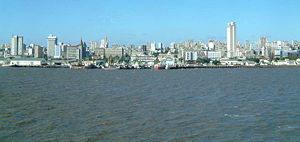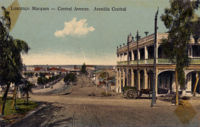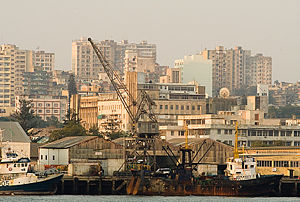Maputo
2008/9 Schools Wikipedia Selection. Related subjects: Africa; Cities
| Maputo | |
| Location in Mozambique | |
| Coordinates: | |
|---|---|
| Country | |
| Government | |
| - Municipal Council President | Eneas Comiche |
| Population (2006) | |
| - Total | 1.244.227 |
Maputo, formerly Lourenço Marques, is the capital and largest city of Mozambique. A port on the Indian Ocean, its economy is centered around the harbour. It has an official population of approximately 1.244.227 (2006), but the actual population is estimated to be much higher because of slums and other unofficial settlements. Coal, cotton, sugar, chromite, sisal, copra, and hardwood are the chief exports. The city manufactures cement, pottery, furniture, shoes, and rubber. There is also a large aluminium smelting plant, Mozal. The city is surrounded by Maputo Province, but is administered as its own province.
Geography
Maputo is located on the west side of Maputo Bay, at the mouth of the Tembe River. The bay is 95 km (50 mi) long and 30 km (20 mi) wide. The Maputo River empties into the southern end of the bay.
History
Founded in 1876, the city was named after Lourenço Marques, the Portuguese trader who was the first European to explore the area in 1544. In 1895, construction of a railroad to Pretoria, South Africa caused the city's population to grow. In 1898, Lourenço Marques became the capital of Mozambique. During the Second Boer War, Winston Churchill, after being captured by the Boers, made a daring escape to Lourenço Marques by slipping past the sentries. After independence, the city's name was changed to Maputo. Maputo's name reputedly has its origin in an old, fierce tribal leader, Maputa, who once ruled over the region.
Transport
Airports
Maputo International Airport is the main international airport of Mozambique. Maputo's transportation needs are mainly served by minibus taxis, which are believed to transport the majority of the city's commuters. There is also a state-owned bus company with a bus fleet that currently numbers some 37 buses. The minibuses are largely used imports from Japan, and they carry most of the public transport activity. There are two major bus terminals in the city: one at Baixa ("downtown"), and another one at Museu ("the Museum").
Infrastructure
Maputo is home to the Universidade Eduardo Mondlane, Mozambique's first university, and to the main campus of the Universidade Pedagógica, another major Mozambican university. The city has a museum of Mozambican history, a military museum, Natural History Museum, and the Roman Catholic Cathedral of Our Lady of Fatima.
Maputo is a planned city with square blocks and wide avenues, with Portuguese traces and their typical architecture of the 1970s. Portuguese refugees fled in massive numbers at the end of the independence war in 1975, and the resultant lack of skills and capital, in the context of a fierce civil war and government mismanagement, contributed to its state of dereliction in the years following the declaration of peace. Nevertheless, the city itself was never damaged, since it was tacitly considered neutral ground during both the colonial and the civil war. Recovery has always been very slow owing to a lack of investment. In many cases new buildings are being erected for the rising middle class, rather than existing buildings being renovated, and many city services are still precarious.
The Maputo beach has been spoiled by waste dumped into the bay, so it is not used for recreation, though the water quality does now appear to be improving.
Culture
Maputo is a melting pot of several cultures, with a strong South African influence. The Bantu and Portuguese cultures dominate, but the influence of Arab, Indian, and Chinese cultures is also felt. The cuisine is diverse, owing especially to the Portuguese and Muslim heritage, and seafood is also quite abundant.
An important cultural and artists' centre in Maputo is the Associação Núcleo de Arte. It is the oldest collective of artists in Mozambique. Seated in an old villa in the centre of Maputo the Núcleo has played a significant role in metropolitan cultural life for decades. Over one hundred painters, sculptors and ceramists are member of the Núcleo, which regularly stages exhibitions on its own premises and over the last few years has actively participated in exchanges with artists from abroad. The Núcleo became well known for their project transforming arms into tools and objects of art. It played an important role for reconciliation after the Mozambican Civil War. The exhibition of art objects such as the Chair of the African King and the Tree of Life was shown around the world, among others in the British Museum in 2006.
Maputo is home to the Dockanema Documentary Film Festival, and international festival showcasing documentary films from around the world. The 2nd DOCKANEMA festival is scheduled for September 14 - 25, 2007, and will include more than 80 films.




